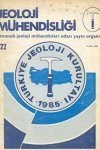
ABSTRACT: The investigated area is located m the mcsrtherii part of the We^t Taurus monutala whose tassement m Sultaııdeıde formation and age is of upper Oambrlaii-Lower Ordovîcian, This unit is unconu formably overlain by a Ua»sic-Lutettaa aged continuous rodänantary sequence, This sequence is basically Consist of pre-MaestrlehMai! carbonates and, pelagic and neriitio deposit!» of Mae»trlchttan-Lutetlait age. Hoyran ophloMtMc melange was emplaced to the region by a tectonic process at the end of Lutetian, During tha Upper Mjowne, tM& basin was filled bj a rapid terrestrial-lacustrine sediments initiated by a new period of tectonic instablMty, In the area, It is found that there are structures related tb Caledöniaaı and Alpine orogenesis. The Mesozolc and Cenozoie aged formattons were folded by the Alpine orageny, On the other hand, it may be said that Paleozoic aged Sultandede- formation was affected by both Oatedonlan and Alpine orogenesis. Sultandede formation could he said to have emerged by the pre Devonian orogenlc phases, Due to erosion, the Lower Ordovieian=Llas*!c aged rocks are not outcropped in the area, The unconformity between Llassic-Lutetlan aged sedîments and the Upper Miocene aged Bafkonak formation may be explained by the Pireneen orogenic phase, In the Pireneen orogenie phase, folds and systematic joint sets also developed to the Liassie=Lutetiân aged sequence, After the Lutetian, the vertical movements In ttie area were primarily dominant and, eonseqently, the faults developed Wmt affected the beds and also fold axes. These faults however, present some difficulty in tracing the fold axes in the long dfetances. The uplifting happened at the end of Pliocene, seems to help clarify the Rodanian onagenlc phase.
ABSTBACT: Sarayönü and Kadınhanı plain İs formed by Upper Miocene and PlJo-Quaiternary.aged lake sediments, TMs plain Is limited from south by Middle Devonkn-aged Ltaratonea and Lover Bevonian-aget] metanuDrpMc schiste, In the lake sediments groundwater levels reached their maximum In April 1981 and their minimum in October 1981, The groundwater levels during these two periods ranged from 0,4 to 2.75 m, At this budget period the height of precipîtotjon on the plain was approximately 400 mm. On the other hand, the calculated amount of the real evapo-transpiration was Etr = 345,18 ,mm. However during1 July, August, September üı 1981 the precipitation had fallen on the plain. Because of the excess of this precipitation Wm reserve of groundwater in October 1981 were comparable increased than of October 1980s The amount of fit can be shown as ; £ §, = 13.3x100 m«. Upper Miocene and Pli-Qmternary aged lake `sédiments are charged by the Kurşunlu formation. Charge rates are Q*n ^ »3.88x10« ntf/per year, Surface flows which occur after heavy raiiis don`t last long their amount is #hown as the twenty percent «af all precipitation (Qr s= £2.2x100 ntf/year)
ABSTRACT: The main cement raw materials in the vicinity of Gençler (Manavgat), are (limestone, clayey limestone and marte of the Miocene, Limestone as limy material, clayey limestone and inaris as siliceous material have been estimated m sufficient reserves. The various pecularities of raw materials anil the other necessary parameters for a cement factory estabiiishement to produce Type i Portland cement are feasible ün this area,
ABSTBACT: Explanation« on the genesis of magmatîc layering is based on on© of the two fondamental processes : Crystal settling and

 TMMOB
TMMOB